Deleveraging Hedge Funds Drag Commodities Lower
Commodities / Resources Investing Sep 10, 2008 - 05:22 PM GMTBy: Frank_Holmes
 Leveraged hedge funds are selling billions of dollars worth of commodities investments to meet their redemption demands, and this is another severe short- term factor driving down prices. Our funds own similar stocks, and thus we are caught up in this powerful force that some have described as a “mechanical sell-off” by hedge funds and banks that need liquidity.
Leveraged hedge funds are selling billions of dollars worth of commodities investments to meet their redemption demands, and this is another severe short- term factor driving down prices. Our funds own similar stocks, and thus we are caught up in this powerful force that some have described as a “mechanical sell-off” by hedge funds and banks that need liquidity.
Adding to the downward pressure are other rumors that “rogue” hedge funds are attacking like sharks when blood is in the water. These predators are allegedly aggressively short-selling the stocks that are in the portfolios of their vulnerable peers, which sends prices even lower.
These hedge fund sharks don't care about fundamentals or portfolio turnover; they're just short-term traders hungry for a quick profit.
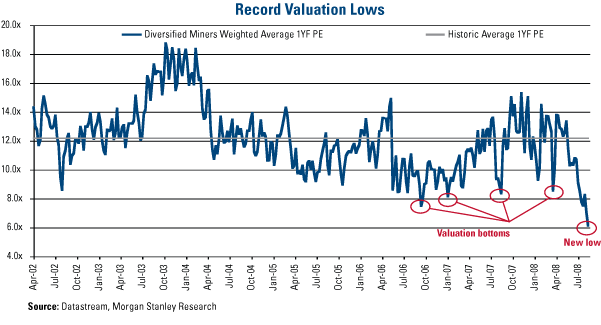
We do care about fundamentals, and the long-term fundamentals for the commodities sector stocks look healthy. These stocks are trading at very low price-to-earnings ratios and at large discounts to cash flow. As we have published in the past and featured in these special commentaries, different commodities rotate in leadership each year; however, long-term supply constraints have not disappeared, and demand from global infrastructure spending continues to remain robust.
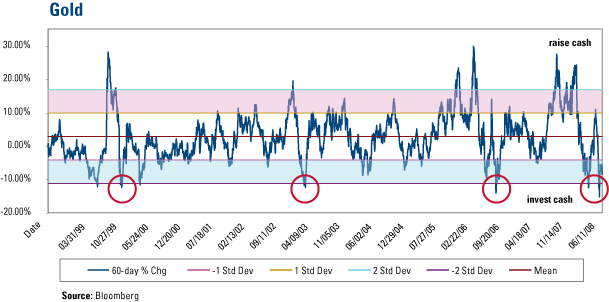

Morgan Stanley recently published a research report on the global mining sector that concludes that we are still in the early to middle years of a commodities supercycle. We agree with this viewpoint, given that many of the key fundamental drivers that have sustained this trend remain intact.
We use oscillators as a tool to monitor price movements over a rolling 60-day trading period. The intensity and magnitude of these price swings, which we measure in bands representing standard deviations above and below the long-term mean, can provide a clue that a price reversal may occur.
On the gold and crude oil oscillators above, it appears that those two natural resources are deeply oversold. Gold's price is more than two standard deviations below the long-term mean over the past 60 trading days, and oil is nearly that far down. The price drop has had a profound impact on the price of the equities linked to these resources.
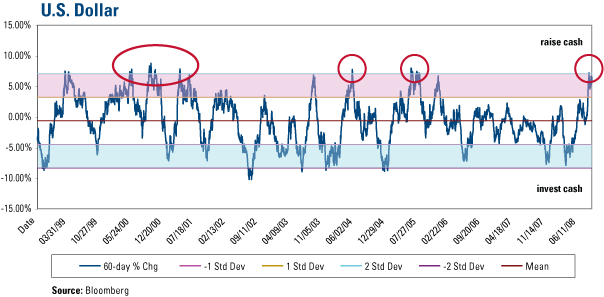
The rising dollar has also contributed to the recent decline in the price of commodities and commodity stocks. Both gold and oil prices tend to move in the opposite direction from the dollar. The dollar is up about two standard deviations over the past 60 trading days—you can see on the dollar chart above that this has happened only a handful of times in the past decade.
You can also see on the oscillator that once the dollar is up two standard deviations, it usually reverses direction and starts correcting to the mean long-term price. If the current rally follows that pattern, we could soon see the dollar again losing value, which would be supportive of oil, commodities and gold.
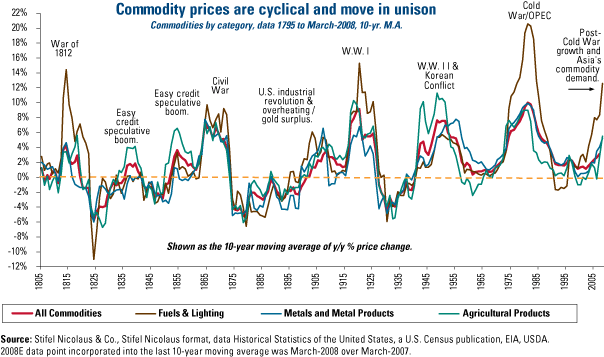
This chart from Morgan Stanley goes back more than 200 years to show cyclical trends in commodities prices. What you see here is that the upswings tend to be sustained for long periods of time before retreating.
These commodities supercycles often last 20 to 25 years, according to Morgan Stanley's research, and if the current one follows the pattern, we have many years to go before it plays out. The key drivers are the rapid economic growth in China and infrastructure spending in other large emerging markets.
While we're in the midst of a supercycle, there are periods of short-term volatility that can be caused by any variety of factors, among them supply and demand issues, governmental policies and market sentiment.
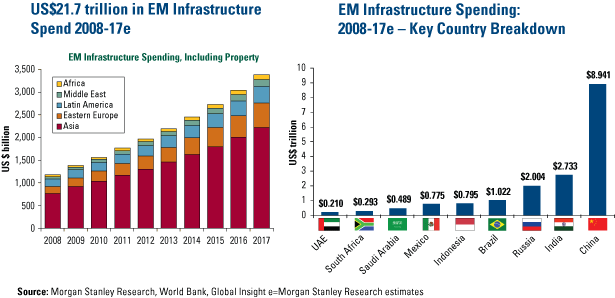
The leveraged hedge funds and their problems aren't the only reason for the current volatility in commodities markets. There's also been reduced demand for these resources and worries linger about the tender state of the U.S. economies and the prospects of a deep global economic slowdown.
Infrastructure spending is the foundation of future commodities demand. We are looking at strong and steady growth in infrastructure spending over the next decade, with most of the billions to be spent on building roads, airports, power generation.
More than $21 trillion is expected to be allocated to infrastructure in emerging markets from this year through 2017, most of it in Asia, followed by Russia and Eastern Europe, and Latin America.
China alone accounts for nearly $9 trillion in this long-term estimate and India's share is pegged at close to $3 trillion. Billions more will be spent in North America, Western Europe and Japan to repair and replace aging infrastructure.
The government in Beijing has made it clear that strong economic growth is its priority, even if it leads to higher inflation. But that pace of growth, in China and elsewhere in the developing world, cannot continue without more and better infrastructure. This recognition that infrastructure spending is a down payment on future growth may keep these projects a priority even in difficult market conditions.
By Frank Holmes, CEO , U.S. Global Investors
Frank Holmes is CEO and chief investment officer at U.S. Global Investors , a Texas-based investment adviser that specializes in natural resources, emerging markets and global infrastructure. The company's 13 mutual funds include the Global Resources Fund (PSPFX) , Gold and Precious Metals Fund (USERX) and Global MegaTrends Fund (MEGAX) .
More timely commentary from Frank Holmes is available in his investment blog, “Frank Talk”: www.usfunds.com/franktalk .
Please consider carefully the fund's investment objectives, risks, charges and expenses. For this and other important information, obtain a fund prospectus by visiting www.usfunds.com or by calling 1-800-US-FUNDS (1-800-873-8637). Read it carefully before investing. Distributed by U.S. Global Brokerage, Inc.
All opinions expressed and data provided are subject to change without notice. Some of these opinions may not be appropriate to every investor. Gold funds may be susceptible to adverse economic, political or regulatory developments due to concentrating in a single theme. The price of gold is subject to substantial price fluctuations over short periods of time and may be affected by unpredicted international monetary and political policies. We suggest investing no more than 5% to 10% of your portfolio in gold or gold stocks. The following securities mentioned in the article were held by one or more of U.S. Global Investors family of funds as of 12-31-07 : streetTRACKS Gold Trust.
Frank Holmes Archive |
© 2005-2022 http://www.MarketOracle.co.uk - The Market Oracle is a FREE Daily Financial Markets Analysis & Forecasting online publication.



